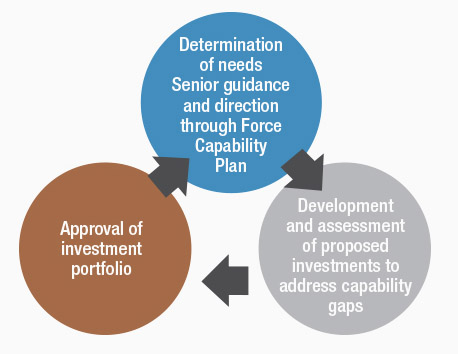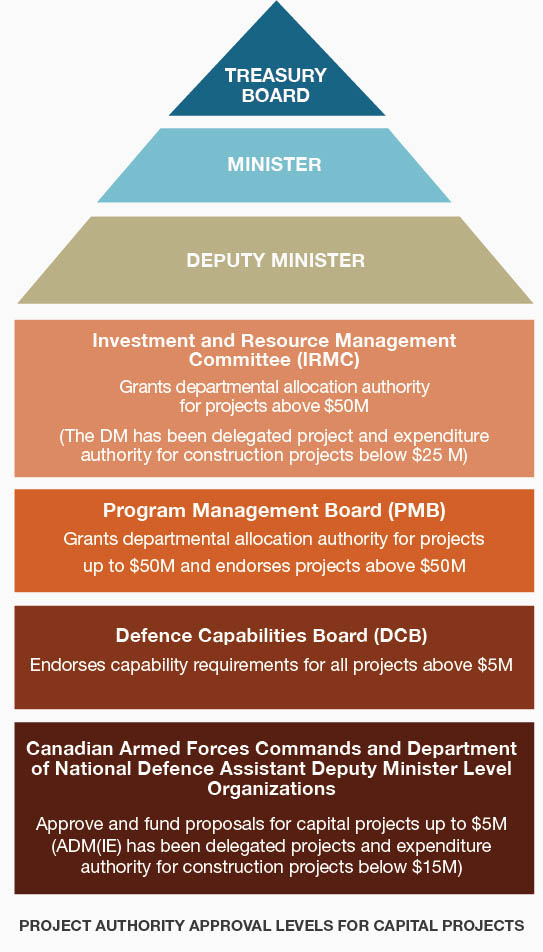Defence Investment Plan 2018 | Part II: Transforming the way National Defence works
2.1 Transforming the way National Defence works
In developing Defence Investment Plan 2018, the Defence Team stepped back to determine not only what it could do better but also what it should do differently. IP 2018 formalizes some important changes to how investments are approved and governed that have been implemented since Defence Investment Plan 2014.
Decisions under the plan are supported by strong, risk-informed, and streamlined governance. The improved governance framework was implemented to ensure that the Defence Team has the flexibility to effectively manage the investments required to meet defence priorities and deliver its programs.
2.1.1 Project planning
The Defence Team’s planning decisions are based on the Canadian Armed Forces’ capability requirements. Investments made are designed to ensure that Forces personnel will have the right infrastructure and equipment required to do their jobs.
The investment planning cycle is illustrated below.

Text version
This illustration shows the investment planning cycle in 3 circles. The top circle is “Determination of needs,” which includes senior-level direction and the Force Capability Plan. It points to the bottom-right circle, “Development and assessment of proposed investments to address capability gaps,” which points to the bottom-left circle, “Approval of investment portfolio,” which in turn points back to the top circle, “Determination of needs.”
A further enhancement is the Project Approval Process Review for low-complexity projects, which previously consumed a high level of resources that was not in alignment with their level of risk. The review process is reducing internal Defence project development and approval time by at least 50% for straightforward projects through improved internal communication, increased delegation, and more efficient departmental approval processes.
2.1.2 Project Selection
Managing investments is a continuous process, subject to revision as capital project costs mature and implementation schedules change, as new requirements and opportunities arise, or as government operational priorities are adjusted. Whatever the scenario, projects proposed for Defence funding are assessed under the Capital Investment Program Plan Review (CIPPR).
CIPPR, an analytical tool developed by the Chief of Force Development organization with significant support from Defence Research and Development Canada, has already demonstrated many benefits. In a programming context, for instance, it provides business analytics decision support and advice to senior Defence leaders to inform capability investment and trade-off decisions. In turn, this confirms that the Defence Team is advancing the right priorities, with a watchful eye towards cost, scope, and schedule risks. As well, if previously approved plans are changed, CIPPR informs decisions regarding re-balancing the investment portfolio to minimize any disruption to capability while respecting fiscal constraints.
As part of broader efforts to improve procurement, the Independent Review Panel for Defence Acquisition (IRPDA) was established in 2015 to provide arm’s length oversight of major defence projects valued over $100 million. Its mandate is to validate the requirements for major military procurement projects by providing independent advice to the Minister and Deputy Minister of National Defence prior to seeking Treasury Board approval or the Minister exercising expenditure authority.
2.1.3 Project costing
The Centre for Costing in Defence was created within National Defence to improve the timeliness and quality of costing information for decision-making. It is responsible for producing life cycle cost estimates for projects over $5 million, as well as implementing leading and best practices in costing in Defence. The organization has two groups: one produces cost estimates, the other conducts cost analytics.
When determining a project’s cost, the Centre creates a point estimate based on a set of assumptions associated with the project. It then does a risk and sensitivity assessment to see what happens to the cost estimate when the underlying assumptions are changed for varying circumstances. The point estimate accounts for all sorts of potential risks, including schedule slippage, foreign currency fluctuation, general inflation in the economy, design changes, and so on.
A robust training program, the International Cost Estimating and Analysis Association certification program, has been instituted for cost estimating specialists. This will result in a significant professionalization of costing capability and capacity to ensure lifecycle cost estimates are based on the latest international body of knowledge and completed in accordance with Treasury Board guidelines.
2.1.4 Project approval
Oversight of capital projects has undergone a substantive transformation to build on best practices and to operationalize the exhaustive costing practices that validated Strong, Secure, Engaged. The overhaul of internal approval procedures also delivers on the policy’s commitment to increase accountability to the public for the expenditure of Canadians’ tax dollars.
Projects under $5 million continue to be completed rapidly through governance mechanisms within senior command and assistant deputy minister level organizations. These authorities, which have existed for many years, enable low-cost projects to be finalized expeditiously. When making investment decisions about projects valued above $5 million, a stringent approval process is applied.
The first governance body for all capability projects over $5 million is the Defence Capabilities Board (DCB). The Board oversees the Identification and Options Analysis phases and endorses project progression into definition. Projects valued over $100 million must undergo additional, third-party reviews by the Independent Review Panel for Defence Acquisition. The Panel reviews and challenges the mandatory requirements of major projects as well as the rationale for the section of the preferred option, basing its assessment on existing project documentation such as the business case analysis and the preliminary statement of operational requirements. The next governance level is the Program Management Board (PMB). The Board evaluates all project proposals in excess of $5 million to recommend the expenditure of capital funds by capital projects through definition and implementation. The PMB is co-chaired by the Senior Associate Deputy Minister, the Vice Chief of the Defence Staff, and the Chief Financial Officer.
The final governance body within National Defence is the Investment and Resource Management Committee (IRMC). Chaired by the Deputy Minister, IRMC is responsible for the effective allocation and management of financial resources and granting departmental approval of funding for capital projects over $50 million.
The committees that oversee National Defence investment planning decisions are depicted below.

Text version
The bottom block of this house-shaped illustration shows that capital projects up to $5 million are approved within senior command and assistant deputy minister level organizations (Note: Assistant Deputy Minister Infrastructure and Environment has delegated authority for construction projects below $15 million). The second block is the Defence Capabilities Board (DCB), which oversees all projects over $5 million. The third block is the Program Management Board (PMB), which evaluates all project proposals over $5 million and approves funding for projects up to $50 million. PMB also endorses projects over $50 million. The final block under the triangular “roof” is the Investment and Resource Management Committee (IRMC), which approves funding for projects over $50 million. IRMC is chaired by the Deputy Minister, who is shown at the bottom of the roof, with the Minister above in the middle, and finally, Treasury Board at the apex of approval levels for capital projects.
2.1.5 Project governance
Life-cycle costing significantly influences investment project approval thresholds, necessitating improvements to governance to ensure the sustainment and affordability of current and future obligations.
Beyond the oversight provided by the committees that approve project funding, the Defence Team has adopted a performance measurement framework to quantify key outputs and performance indicators for annual investment planning. Among the variables being tracked, the framework assesses whether risk-related governance processes will burden the approval process, if new investments have sufficient funding prior to approval, if information systems are in place to support investment planning, and whether the Defence Team has the capacity to deliver priority investments. This comprehensive framework provides senior executives with an objective view of both planning and implementation processes.
Equally rigorous is the governance practiced in the award and management of the sustainment and operating contracts that follow formal commissioning processes. The National Procurement Oversight Committee provides strategic advice and makes recommendations on equipment sustainment activities and priorities, facilitates their implementation, and resolves issues related to national procurement management. Specific to infrastructure investments, the Integrated Project Delivery method amalgamates people, systems, business structures, and practices to harness the talents and insights of all participants to reduce waste and optimize efficiency through all phases of design, fabrication, and construction.
Managing risks
A critical aspect of project governance is the assurance that risks have been fully assessed and mitigated. Of course, it is impossible to eliminate all risk; however, most risks can be avoided or mitigated. Defence Investment Plan 2018 includes sufficient flexibility and an appropriately responsive governance system, ensuring that risks should be manageable:
- National Defence investment governance has matured and strengthened significantly since previous investment plans, including leveraging business intelligence and business analytics
- Acquired goods and services have been mapped for current and future expenditures
- National Defence’s Centre for Costing in Defence is now involved earlier in the planning process, improving the timing and quality of costing provided for decision making
- The Defence Team is growing and professionalizing the defence procurement workforce to strengthen its capacity to manage the acquisition and support of today’s complex military capabilities, including the addition of procurement specialists, enhanced staff training, and professional accreditation of defence procurement personnel